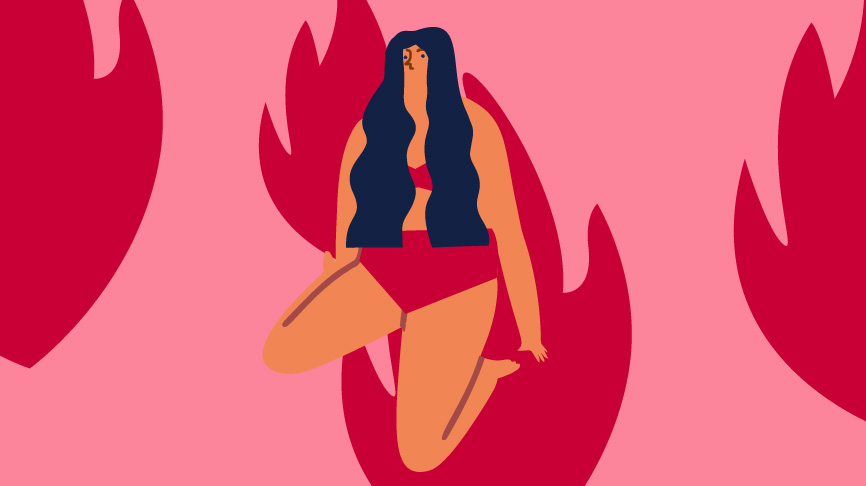The Best Ways to Relieve Hot Flashes During Menopause

Hot flashes – also called hot flushes – are characterized by a sudden sensation of intense heat, often causing sweating and a reddening of the face. Linked to the onset of menopause, they’re thought to affect around 80% of women and can be deeply uncomfortable.
For some, they can trigger symptoms such as headache, nausea and even dizziness. Worse still, they can strike at any time and prove pretty disruptive in a woman’s life.
Hot Flashes: What Are They and When Do They Strike?
For most of us, hot flashes occur as a symptom of menopause: defined as a period of twelve months without menstruation, it’s caused by the ovaries ceasing to produce eggs. An entirely natural process, it’s also a gradual one, with the lead-up to the menopause proper called the perimenopausal transition. Whilst the average age for women to start experiencing symptoms is 51, it can also strike as early as during the 30s or as late as the 60s.
Hot flashes are a common symptom of this perimenopausal transition, and whilst they’re not wholly understood, it’s thought that a decline in the hormone estrogen affects the body’s ability to regulate temperature, also known as thermoregulation.
During a hot flash the brain senses the body is overheating, regardless of its actual temperature. To cool down, the blood vessels close to the skin in the head, face, neck and chest dilate, often accompanied by sweating. This sudden sensation of intense heat, combined with flushing of the skin is called a hot flash.
Uncomfortable though they are, hot flashes are completely normal and for many, an unavoidable symptom of the onset of menopause. Whilst medical treatments can certainly help – specifically hormone replacement therapy (HRT) to boost the body’s levels of estrogen and progestin – here are some natural alternatives to control the frequency and severity of hot flashes.
Keep Cool
An obvious strategy for managing hot flashes is, unsurprisingly, to stay cool. Adjust your thermostat or use fans to keep temperatures low, particularly in the bedroom to avoid unpleasant night sweats. During the day, chose loose, layered clothing that can be easily removed when flashes strike, ideally in natural materials to help wick perspiration away from the body. Linen is a good choice, as is bamboo, or else check your local outdoor supply store for synthetic materials specifically designed to keep you cool.
Know Your Triggers
For many, knowing and avoiding environmental or dietary triggers can help control those uncomfortable rushes of heat. Although varying from woman to woman, common culprits include stress, cigarette smoke and unsurprisingly, heat.
Caffeine can be problematic on two counts: not only is it a stimulant that affects the central nervous system; if you get your caffeine kicks from a steaming cup of coffee or tea, the heat surge from that first sip can trigger a hot flash. For the same reason, spicy foods should be approached with caution…
Work Up a Sweat
Exercise is a great habit to get into at any age, but can be particularly beneficial in the run-up to menopause. Getting those endorphins pumping can help reduce stress levels, a common trigger for hot flashes.
An added benefit, it can also help maintain a healthy body weight when combined with a healthy diet: a high body mass index (BMI) has been linked to increased frequency of hot episodes. Not the exercising type? Deep abdominal breathing can also help with relaxation, beating common triggers of stress and anxiety.
Acupuncture
A 2011 study in Turkey noted a significant reduction of hot flashes in a test group of 53 postmenopausal women after a ten-week long program of acupuncture. Involving the insertion of needles at specific pressure points on the body, it’s a traditional Chinese therapy and should only be carried out by licensed acupuncturists.
Practitioners believe the kidneys’ energy – or jing – can help counteract heat from the heart and liver and so target these key organs by inserting needles in the feet, legs and arms. An alternative therapy that’s been shown to be effective, speak to your doctor about whether acupuncture could help manage your symptoms.
Plant-based Alternatives
Whilst the jury’s still out on the efficacy of herbal remedies in managing hot flashes, many women swear by them – ask your doctor for their thoughts on whether plant-based therapies are for you. One of the more popular alternative treatments out there is black cohosh, also known as squawroot.
The plant’s roots are dried before being ground into a powder, and are available in tablet form. Another supplement to consider is red clover, rich in an estrogen-like substance called isoflavones which may mimic the effects of hormone. Finally, wild yam contains a compound called diosgenin which is also thought to be similar to estrogen. In conjunction with other alternative treatments, herbal remedies might just work for you – just be sure to consult with a doctor first.
Disruptive, uncomfortable and for many, unavoidable, hot flashes are an unpleasant side effect of menopause. For most women who experience them, episodes occur for at least one year, and whilst they’re not yet wholly understood, there’s a whole host of natural alternatives that could help to beat the heat.
Please note that advice offered by Intimina may not be relevant to your individual case. For specific concerns regarding your health, always consult your physician or other licensed medical practitioners.

A collective group of “lady experts” at Intimina who love sharing our personal experiences, even when they are a little too personal. We believe it’s time to start breaking down the taboos around menstruation, motherhood, and menopause, and start owning our female health.


